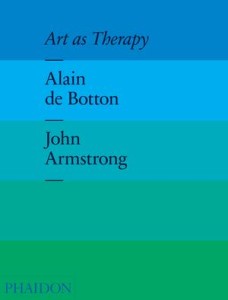Art as Therapy
A review of Art as Therapy by Alain de Botton and John Armstrong
written by Hearth Member, Amy Beth Harrison
How therapeutic is looking at art for you? The point of Art as Therapy by Alain de Botton and John Armstrong is that the experience could be so much better. 
I wouldn’t be a visual artist if I didn’t believe in the power of images. One of my most potent art memories is climbing up a winding staircase set in plants to find the Matisse paper cut room bursting with color and organic line at the National Gallery in DC. I had just graduated high school and was visiting my older sister on my way cross country to go to college. It was my first time in a world-class museum, and I remember feeling like I had found a magical hideout. However, there have also been plenty of museum/gallery visits where everything I saw hit my mind but not my heart.
Botton and Armstrong feel that a major shift should occur in the artworld. If we really want art to be relevant to society, we need to deeper mine its therapeutic abilities: “Like other tools, art has the power to extend our capacities beyond those that nature has originally endowed us with. Art compensates us for certain inborn weaknesses, in this case of the mind rather than the body, weaknesses that we can refer to as psychological frailties” (5).
Art can help us remember what is important. A Vermeer might help us remember that the quiet moments in life are essential. A Korean moon jar–in its embrace of the beauty of imperfections–might remind us of the value of modesty. Looking at and pondering art we react strongly against can help us develop an ability to like things that we at first find strange.
The most insightful part of the book for me was when the authors suggest what changes the artworld can make. They discuss how art could be made, bought, and displayed with a therapeutic reading. Artists could be commissioned for art that fits a certain psychological need. Art schools could teach principles of therapy as they relate to art making. More money would become available for artists as their role in society was seen as more useful. Collectors would buy art based not on investment but what was helpful to their personal maladies. Museums would provide meaningful experiences instead of places to store historical facts.
To quote the authors about the building of the Kimbell Art Museum:
The benefactors, trustees and architect went to extraordinary lengths to create a beautiful environment that would focus our attention on the artworks and proclaim the dignity of art; thus the museum implicitly argues the tremendously significant experiences are to had within its galleries.
What are these experiences, exactly? The Kimbell takes us to the brink of a crucial idea: that the great themes of existence can be addressed in elevating material spaces. It makes all the right preparatory moves…. But then it stops short, and never encourages us to reform our lives under the guidance of art. It is often said that the great museums are the cathedrals of the modern world, but the comparison reveals the weakness of contemporary secular galleries, rather than flattering them. Cathedrals were created as compelling statements of a complete theory of life: of our deepest needs, our spiritual destiny and the guidance necessary to live the right life. This religious project may have lost its allure, but we should hold on to the scale and sincerity of its intent (92).
The way that they propose museums to change is to base floor plans not on historical areas but instead on therapeutic function. A possible layout could include a Gallery of Self-Knowledge, a Gallery of Love, Gallery of Fear, Gallery of Compassion, and a Gallery of Suffering. They also propose that captions should help move the viewer towards this viewing. Here is an excerpt from a possible caption for Juan de Flandes Christ Appearing to His Mother:
This is an image of a loving mother-son relationship. But it does not avoid conflict or grief: these are precisely what the picture says are central to love. It is a very restrained image. They do not embrace. He will soon leave. How often has this scene been re-enacted?
This picture makes the claim that such moments of return (and of survival), though fleeting and rare, are crucially important in life. It wants men to understand–and call–their mothers (88).
I would love to see a whole museum full of such captions. What an experience that would create!
I deeply agree that adding a therapeutic aspect to the art world is needed. However, I didn’t always agree with all the captions on the artwork as how to interpret them. Different styles of therapy are helpful to different people and this would have to be true for interpreting artwork as well. In response to their museum re-imaginings, I do not think tossing out all historical readings of a piece is good–these can add to our psychological understandings of the work. I personally research historical emotional development, and this discussion–how people experienced emotion in the past is different and similar to our own–can be very helpful in imaging new ways to deal with psychological problems. I also believe strongly as an artist in the power of self-expression. Seeing someone’s true expression can have power through it’s beauty, clarity, or insight that might not be strictly therapeutic. The power of an art piece is that it can be read many different ways and it never has just one meaning, therapeutic or otherwise. If one was to commission therapeutic artwork, some artists are going to be able to better create images for some psychological problems over others. It’s hard to make powerful art about something you haven’t experienced yourself.
However, I do believe that the art world should shift from a facts-only experience to a more emotive one and help the average, untrained viewer make this transition. It’s something I intend to try out more as a museum educator.
For more inspiration check out the School of Life that Alain de Botton started. It’s quite amazing. They also do bibliotherapy!

Pingback: anti kasma oc()
Pingback: seks izle()
Pingback: seks izle()
Pingback: seks izle()
Pingback: sekis izle()
Pingback: sekis izle()
Pingback: movie2k()
Pingback: porno()
Pingback: orospunun evladi()
Pingback: buy backlinks()
Pingback: reserver hotel de luxe pas cher()
Pingback: free fico scores from all three bureaus()
Pingback: warehouses for sale Miami()